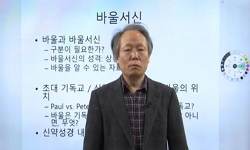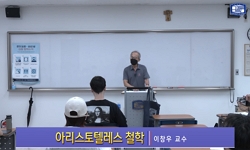본 연구의 목적은 고전수사학을 바탕으로 바울의 수사학을 탐구하는 데 있다. 좀 더 구체적으로 말하자면 본고는 아리스토텔레스에게 토대를 두고 있고 그리스-로마 수사가들이 따르고 있...
http://chineseinput.net/에서 pinyin(병음)방식으로 중국어를 변환할 수 있습니다.
변환된 중국어를 복사하여 사용하시면 됩니다.
- 中文 을 입력하시려면 zhongwen을 입력하시고 space를누르시면됩니다.
- 北京 을 입력하시려면 beijing을 입력하시고 space를 누르시면 됩니다.
고전수사학을 통한 바울의 수사학 탐구 : 고린도전서를 중심으로 = Inquiry on Paul’s rhetoric through classical rhetoric : focusing on 1 corinthians
한글로보기https://www.riss.kr/link?id=T15499921
- 저자
-
발행사항
서울 : 숭실대학교 대학원, 2019
-
학위논문사항
학위논문(박사)-- 숭실대학교 대학원 철학과(일원) 2019. 12
-
발행연도
2019
-
작성언어
한국어
- 주제어
-
DDC
808 판사항(23)
-
발행국(도시)
서울
-
형태사항
viii, 188 p. ; 26 cm
-
일반주기명
숭실대학교 논문은 저작권에 의해 보호받습니다.
지도교수: 백도형, 문영식
참고문헌: p. 182-188 -
UCI식별코드
I804:11044-200000280994
- 소장기관
-
0
상세조회 -
0
다운로드
부가정보
국문 초록 (Abstract)
본 연구의 목적은 고전수사학을 바탕으로 바울의 수사학을 탐구하는 데 있다. 좀 더 구체적으로 말하자면 본고는 아리스토텔레스에게 토대를 두고 있고 그리스-로마 수사가들이 따르고 있는 수사학의 세 가지 종류 중 하나를 바탕으로 바울 서신, 특별히 고린도전서를 탐구한다. 연구방법은 크게 네 가지로 이루어진다. 먼저 바울이 고전수사가로서 자격을 가질 수 있는가의 문제이다. 둘째, 바울 서신이 수사학의 범주 안에 있다는 탐구이다. 셋째, 고린도전서가 심의연설로 평가된다는 점이다. 넷째, 고린도전서의 구성이 심의연설의 입장에서 구체적으로 분석된다. 이런 연구는 이소크라테스, 아리스토텔레스, 디오 크리소스톰, 그리고 플루타르크와 같은 고전 수사학자들의 이론을 근거로 이루어지며 미첼, 벤 위더링톤 3세와 같은 현대의 연구가들의 주장을 토대로 진행된다.
첫째, 바울은 고전수사학의 탐구 대상이 될 수 있다. 이는 바울이 수사가라는 사실을 분명히 한다. 바울의 성장배경이나 바울의 자기진술을 심도 있게 들여다 볼 때 바울이 수사가이며 고전수사학의 탐구 대상으로서 자격을 갖는다. 바울의 성장배경을 살펴볼 때 바울은 시대적으로 그리스-로마 교육에서 자유로울 수가 없었다. 당시에 그리스-로마 교육이 수사학에 초점이 맞춰져 있었기 때문에 바울은 직접적이든 간접적이든 수사학 교육의 영향 아래 있었다. 비록 바울의 자기진술이 그의 성장배경과 차이를 보이고 있지만 바울의 자기진술 역시 수사학적 입장에서 이해될 수 있으며 바울이 수사가로서 자격을 갖추고 있음을 보여준다.
둘째, 바울 서신은 고전수사학의 범주 안에 있다. 바울 서신과 수사학의 관계를 살펴볼 때 우리는 바울 서신이 단순히 그리스-로마 편지 쓰기의 범주 안에 있지 않고 수사학의 범주 안에 있음을 발견한다. 특별히 본론 부분은 수사학 전통을 따르고 있으며 수사학의 범주 안에서 탐구될 수 있다. 바울 서신이 공동체를 위한 연설이며 구두연설의 기능을 하고 있다는 사실은 이를 분명히 해 준다.
셋째, 바울 서신, 특별히 고린도전서를 수사학적으로 분석하는 내용이다. 고린도전서는 연설의 세 가지 종류 중 심의연설의 특징을 보여준다. 이는 시간의 초점이 미래이며 이로움에 대한 호소이며 예시들을 사용하며 일치를 추구하는 것을 통해 드러난다. 이런 것들은 심의연설의 요소들로 고린도전서 전반에서 발견된다. 특별히 심의연설로서 고린도전서는 정치적인 수사학에서 사용되는 토포스들로 엮여져 있다. 고린도전서 내에는 그리스-로마 문학이나 정치학에서 사용되는 토포스들의 사용이 두드러진다. 이는 고린도 공동체의 통합과 일치를 위한 심의연설의 목적에 부합한다.
넷째, 고린도전서의 수사학적 구성에 대한 분석이다. 이는 고린도전서의 수사학적 구조에 대한 개괄이며 구성에 대한 구체적인 탐구이다. 고린도전서의 수사학적 구성은 심의연설로 바울의 핵심적인 의도가 담겨있다. 고린도전서는 크게 네 부분으로 구성된다. 그것은 서신의 서문, 수사학적 도입부에 해당되는 서신의 감사, 서신의 본론, 서신의 맺음말이다. 특별히 본론은 서신의 모든 논증이 집중되며 수사학적 구성에 의해 작문되는 곳이다. 본론은 명제를 시작으로 네 개의 증명들로 구성되어 있으며 그에 상응하는 표제들과 하위논증들로 배열되어 있다. 본론에서 증명들과 그에 따른 표제들과 하위논증들은 일관된 목적을 가지고 있다. 그리고 그 목적은 고린도 공동체의 파벌을 견제하고 일치와 통합을 권고하는 데 있다.
바울을 수사가로 인정하고 바울 서신을 수사학적 입장에서 접근하는 데 있어 우리는 철학과 성서신학 사이에 어떤 접점을 발견할 수 있다. 따라서 수사학의 입장에서 성서를 분석하는 연구가들은 그것들의 영역을 자유롭게 넘나든다. 하지만 미첼과 같은 연구가는 성서신학의 영역보다는 고전수사학의 입장에서 바울 서신을 이해한다. 미첼은 고전 수사가들의 이론을 바탕으로 고린도전서를 이해하고자 노력하는 학자이다. 본 논문은 성서신학의 범주를 넘지 않고자 노력한다. 그리고 본 논문은 미첼의 연구에 많은 부분 신세를 지고 있으며 성서수사학이 아닌 고전수사학을 토대로 바울을 이해하고 고린도전서를 심의연설로 분석한다.
다국어 초록 (Multilingual Abstract)
The purpose of this study is to inquire into Paul’s Rhetoric based on Classical Rhetoric. More specifically, in this paper I investigate Paul’s letter, particularly 1 Corinthians, which is based on one of three species of Classical Rhetoric that a...
The purpose of this study is to inquire into Paul’s Rhetoric based on Classical Rhetoric. More specifically, in this paper I investigate Paul’s letter, particularly 1 Corinthians, which is based on one of three species of Classical Rhetoric that are derived from Aristotle and that Greco-Roman rhetoricians follow. The research methods consist of four parts. First, this is the problem on whether Paul has qualifications as a rhetor. Second, this is the inquiry that the Pauline Epistles are within the category of Rhetoric. Third, this is the point that 1 Corinthians is recognized as deliberative rhetoric. Fourth, we concretely analysis the composition of 1 Corinthians on deliberative species. Theses studies are achieved, based on the theories of Classical rhetoricians such as Isocrates, Aristotle, Dio Chrysostom, and Plutarch, and done on the argument of modern researchers such as Margaret M. Mitchell, and Ben Witherington Ⅲ.
First, Paul can be a subject of inquiry of Classical Rhetoric. This makes sure that Paul is a rhetor. As we take a closer look at his own life and his autobiographical statements, Paul is qualified as an object of inquiry of Classical Rhetoric. Taking a look at his own life and the process of his growth, Paul was never free of the influence of Greco-Roman education. In those days, Greco-Roman education focusing on Rhetoric, Paul was directly or indirectly open to the rhetorical education. Though showing the difference with his own life, his autobiographical statements can also be understood from a rhetorical point of view and reveal that Paul is qualified as a rhetor.
Second, the Pauline Epistles are within the category of Classical Rhetoric. As we inspect the relation between the Pauline Epistles and Rhetoric, we find that the Pauline Epistles are not within the category of Greco-Roman Letter Writing but within that of Classical Rhetoric. In particular, the main body follows the rhetorical tradition and can be studied in the rhetorical category. The fact that the Pauline Epistles are orations for communities and have a function of oral speeches clarifies these.
Third, I analyze Paul’s letter, particularly 1 Corinthians. 1 Corinthians shows the characteristics of deliberative species of three species. This is revealed in that deliberative rhetoric is the frame of future time, uses examples, appeals to advantage, and advises concord. These are found as the elements of deliberative rhetoric throughout 1 Corinthians. Especially, 1 Corinthians as deliberative species consists of topoi used in political rhetoric. In 1 Corinthians, topoi used in Greco-Roman literature or politics stand out. This is in line with the purpose of deliberative species for unity and concord of Corinth Community.
Fourth, this is analysis of rhetorical composition of 1 Corinthians. This is a summary of rhetorical structure and the detailed research of composition of 1 Corinthians. The key element of Paul as deliberative species is in rhetorical composition. 1 Corinthians is made up of four parts. These are Epistolary Prescript, Epistolary Thanksgiving forming the introduction to the argument in the body the letter, Epistolary Body, and Epistolary Closing. In particular, the body is the place all argumentation of the letter is concentrated and is written according to rhetorical composition. The body consists of four sections of proof with proposition/thesis statement as a start, and is arranged in heads and sub-arguments corresponding to those. In the body, proofs, heads, and sub-arguments have the consistent purpose. And the purpose is to keep factionalism of Corinth Community in check, and to advise reconciliation and unity.
We accept Paul as a rhetor, and in making an approach to Paul’s letter based on Rhetoric, can find any interface between Philosophy and Biblical Theology. Therefore, researchers analyzing the Scriptures on Rhetoric freely cross the border of them. However, Researcher like Margaret M. Mitchell investigates Paul’s letter on Classical Rhetoric rather than the category of Biblical Theology. Margaret M. Mitchell is a scholar to make an effort to understand 1 Corinthians on the theories of Classical rhetoricians. In this paper, I try not to cross the category of Biblical Theology. And I owe many ways to her study, understand Paul on Classical Rhetoric, and inquire into 1 Corinthians as deliberative species.
목차 (Table of Contents)
- 제 1 장 문제제기 및 연구방향 1
- 제 2 장 고전수사학의 탐구대상으로서 바울 9
- 2.1 바울의 자기진술 10
- 2.1.1 고린도전서 1-4장에 나타난 자기진술 10
- 2.1.2 고린도전서에 나타난 세속적 논증: 소피아와 로고스 13
- 제 1 장 문제제기 및 연구방향 1
- 제 2 장 고전수사학의 탐구대상으로서 바울 9
- 2.1 바울의 자기진술 10
- 2.1.1 고린도전서 1-4장에 나타난 자기진술 10
- 2.1.2 고린도전서에 나타난 세속적 논증: 소피아와 로고스 13
- 2.1.3 고린도 공동체의 수사학적 상황: 소피스트 수사학 15
- 2.1.4 수사학을 반대하는 수사학 19
- 2.2 바울의 성장과 교육배경 22
- 2.2.1 바울의 공식적인 수사학 교육을 부정하는 견해 22
- 2.2.2 바울의 공식적인 수사학 교육을 긍정하는 견해 25
- 2.3 결론: 바울 서신의 수사학적 탐구 가능성 31
- 제 3 장 바울 서신의 수사학적 범주 35
- 3.1 바울 서신의 형식에 대한 두 가지 입장 35
- 3.2 공동체를 향한 연설로서의 바울 서신 39
- 3.3 바울 서신의 수사학적 증거 43
- 3.3.1 그룹/공동체 연설: ‘형제들아’ 43
- 3.3.2 구두 연설 45
- 3.3.3 쓰기와 말하기 48
- 3.4 결론 51
- 제 4 장 고린도전서의 수사학적 분석 53
- 4.1 연설의 세 가지 종류 53
- 4.2 심의연설로서의 고린도전서 57
- 4.2.1 심의연설의 시간 틀: 미래 59
- 4.2.1.1 미래행동 선택의 심의 59
- 4.2.1.2 고린도전서의 미래 지향적 진술 60
- 4.2.2 이로움에 호소 61
- 4.2.2.1 심의연설의 전략: 이로움에 호소 61
- 4.2.2.2 이로움에 호소하는 고린도전서 65
- 4.2.3 예시 사용 69
- 4.2.3.1 심의연설의 예시 사용과 그 기능 69
- 4.2.3.2 고린도전서의 예시 사용과 그 기능 74
- 4.2.4 파벌과 일치 79
- 4.2.4.1 심의연설의 일치 촉구 79
- 4.2.4.2 고린도전서에서 파벌과 일치를 드러내는 토포스들 81
- 4.2.4.2.1 불화, 지혜, 변론가, 혈통, 자랑(1장) 81
- 4.2.4.2.2 건물, 소유, 거만한 것(3장; 4장) 85
- 4.2.4.2.3 음행, 연합(5장) 88
- 4.2.4.2.4 법적 분쟁, 신체/몸(6장; 12장) 89
- 4.2.4.2.5 결혼(7장) 92
- 4.2.2.2.6 우상 제물, 약한 자와 강한 자(8장) 93
- 4.2.4.2.7 예시, 종교의식, 이로움(10장) 95
- 4.2.4.2.8 분열, 무질서 화평(14장) 97
- 4.2.4.2.9 부활(15장) 99
- 4.3 결론: 요약 101
- 제 5 장 고린도전서의 수사학적 구성 103
- 5.1 고린도전서의 수사학적 구조에 대한 개괄 104
- 5.2 고린도전서의 수사학적 구성 105
- 5.2.1 서문(1:1-3): 심의연설의 대상으로서 ‘에클레시아’ 105
- 5.2.2 감사/수사학적 도입(1:4-9) 108
- 5.2.3 본론(1:10-15:58) 109
- 5.2.3.1 명제(1:10) 110
- 5.2.3.2 담화(1:11-17) 116
- 5.2.3.3 증명(1:18-15:57): 일치의 추구 118
- 5.2.3.3.1 증명1: 권고의 필요성(1:18-4:21) 120
- 5.2.3.3.2 증명2: 공동체의 순결(5:1-11:1) 128
- 5.2.3.3.2.1 표제1: 음행과 공동체 결속(5:1-7:40) 129
- 5.2.3.3.2.1.1 하위논증: 음행(5:1-13; 6:12-20), 법정 분쟁(6:1-11), 결혼문제(7:1-40) 129
- 5.2.3.3.2.2 표제2: 우상숭배(8:1-11:1) 134
- 5.2.3.3.2.2.1 하위논증: 우상제물과 분열(8:1-13), 예시(9:1-27; 10:1-13), 우상숭배와 통합(10:14-22) 136
- 5.2.3.3.2.3 증명2의 결론: 공동의 이로움을 위한 호소 (10:23-11:1) 145
- 5.2.3.3.3 증명3: ‘함께 모일 때’ 발생하는 파벌(11:2-14:40) 148
- 5.2.3.3.3.1 표제1: 예배에서의 불화(11:2-16) 149
- 5.2.3.3.3.2 표제2: 주의 만찬에서의 분열(11:7-34) 152
- 5.2.3.3.3.3 표제3: 신령한 은사(12:1-14:40) 156
- 5.2.3.3.3.3.1 하위논증: 은사와 그리스도의 몸(12:1-31a), 예시(12:31b-14:1a), 은사(방언/예언)와 통합(14:1b-40) 156
- 5.2.3.3.4 증명4: 부활과 마지막 목적(15:1-57) 165
- 5.2.3.4 본론의 결론(15:58) 169
- 5.2.4 맺음말(16:1-24) 171
- 5.3 결론: 요약 175
- 제 6 장 전체 결론: 요약 및 평가 177
- 참고문헌 182













